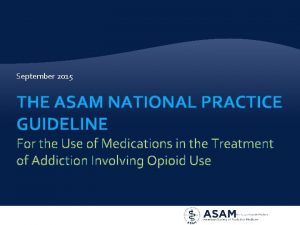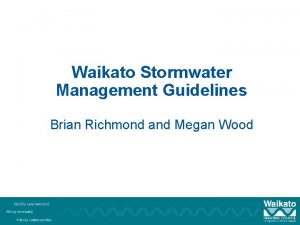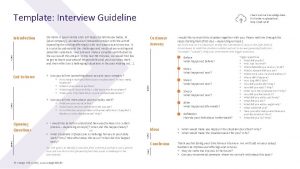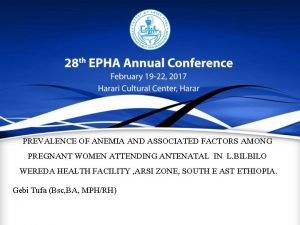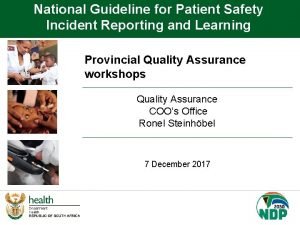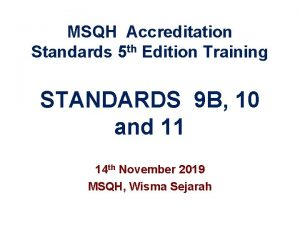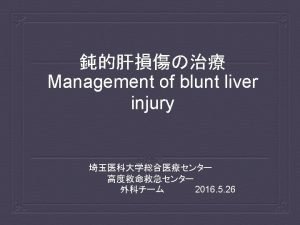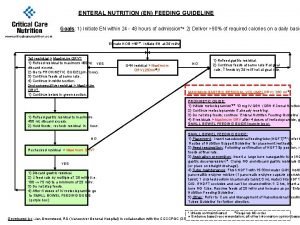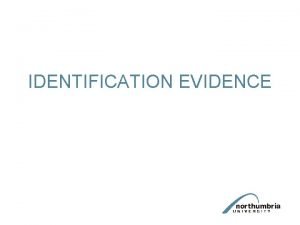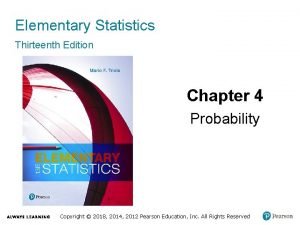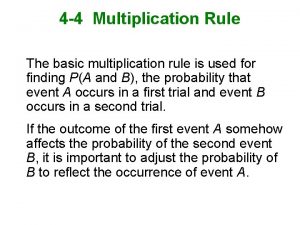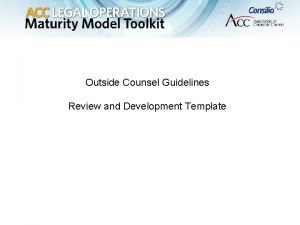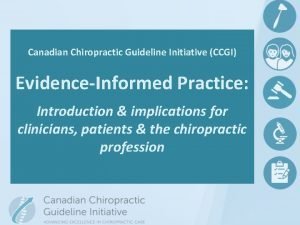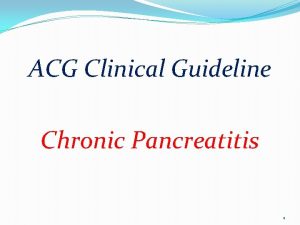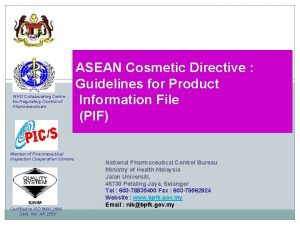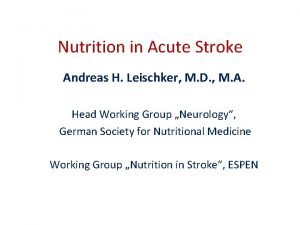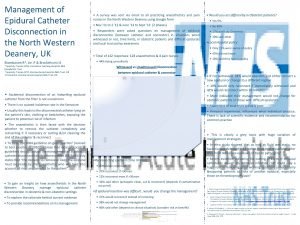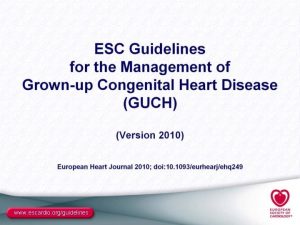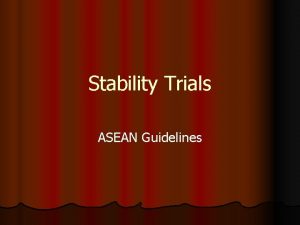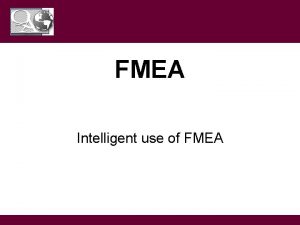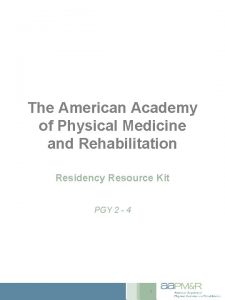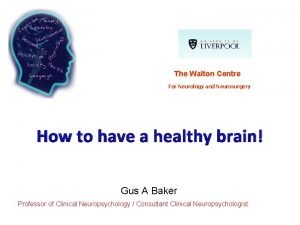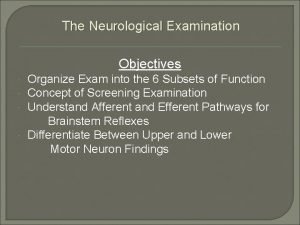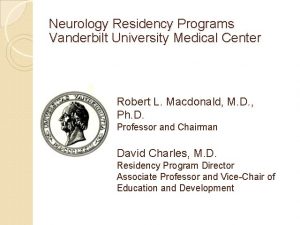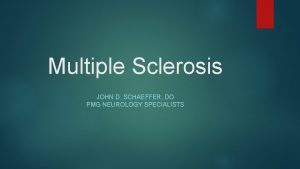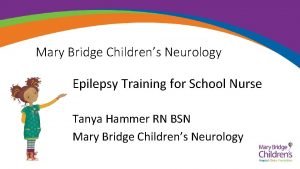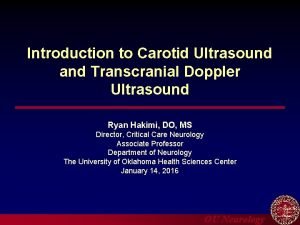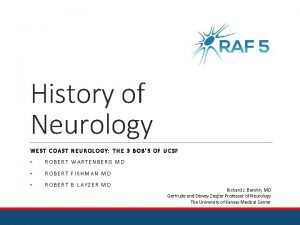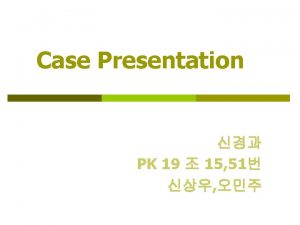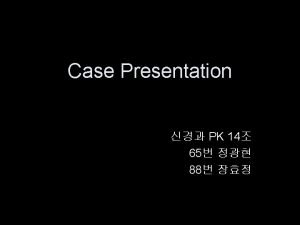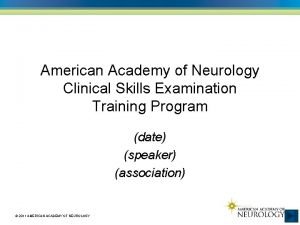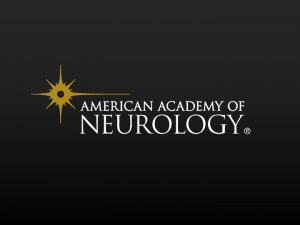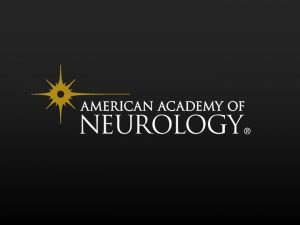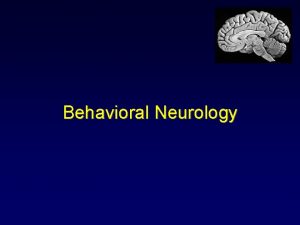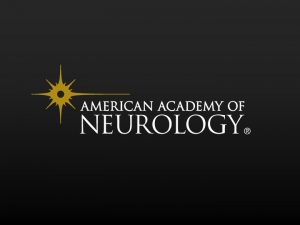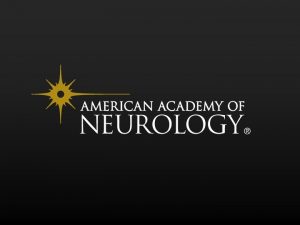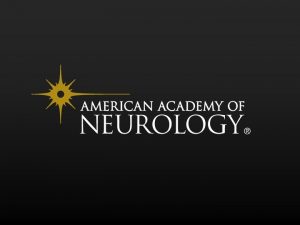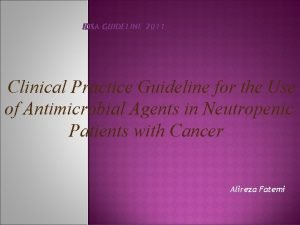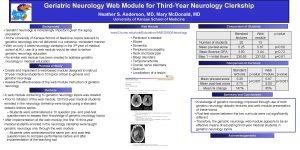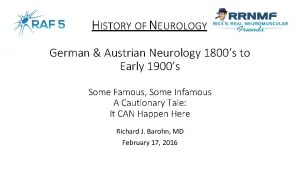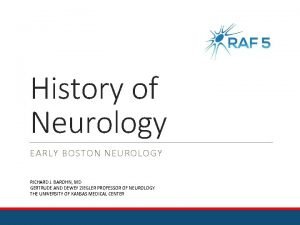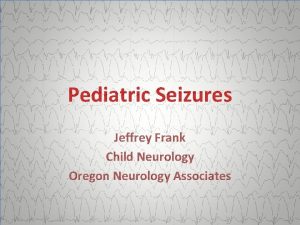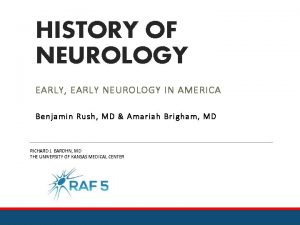2016 American Academy of Neurology Practice Guideline Treatment














































- Slides: 46

© 2016 American Academy of Neurology

Practice Guideline Treatment of Restless Legs Syndrome in Adults Report by: Guideline Development, Dissemination, and Implementation Subcommittee of the American Academy of Neurology © 2016 American Academy of Neurology

Guideline Funding This guideline was developed with financial support from the American Academy of Neurology. Authors who serve or served as AAN subcommittee members or methodologists (M. J. A. , G. S. G. , D. G. , T. Z. ) were reimbursed by the AAN for expenses related to travel to subcommittee meetings where drafts of manuscripts were reviewed. © 2016 American Academy of Neurology Slide 2

Sharing This Information The American Academy of Neurology (AAN) develops these presentation slides as educational tools for neurologists and other health care practitioners. You may download and retain a single copy for your personal use. Please contact guidelines@aan. com to learn about options for sharing this content beyond your personal use. © 2016 American Academy of Neurology Slide 3

Presentation Objectives To make evidence-based recommendations regarding restless legs syndrome (RLS) management in adults. © 2016 American Academy of Neurology Slide 4

Overview § Introduction § Clinical questions § AAN guideline process § Methods § Conclusions § Practice recommendations © 2016 American Academy of Neurology Slide 5

Introduction § Restless legs syndrome (RLS) is a movement disorder that is characterized by an urge to move the legs or arms, commonly in response to an uncomfortable dysesthesia. § It has the following 3 features: § It is present at rest (sitting or lying down) § It is relieved (often only temporarily) by movement of the affected limb § It is most pronounced in the evening or at night. e 1 § Clinical mimics (e. g. , positional discomfort, leg cramps) cannot solely account for the symptoms. § Diagnosis is made by clinical interview. § RLS severity exists along a continuum from occasionally annoying to severely disruptive to quality of life (Qo. L). © 2016 American Academy of Neurology Slide 6

Clinical Question This practice guideline addresses the following question: • What are safe and effective therapies, including both pharmacologic and nonpharmacologic approaches, for the symptoms and clinical consequences (disturbed sleep, periodic limb movements of sleep [PLMS], depression/anxiety, and decreased Qo. L) of RLS in adults? © 2016 American Academy of Neurology Slide 7

AAN Guideline Process* • Clinical Question • Evidence • Conclusions • Recommendations *Guideline developed using the 2004 AAN Clinical Practice Guideline Process Manual. © 2016 American Academy of Neurology Slide 8

Literature Search/Review Rigorous, Comprehensive, Transparent 2, 729 abstracts 290 rated articles © 2016 American Academy of Neurology Three databases (MEDLINE, Embase, and Science Citation Index) were searched from 1966 to December 2007. An updated identical search was performed to include articles published from December 2007 to August 2011. Inclusion criteria: Exclusion criteria: • Original article described treatment of RLS • Study lasted longer than a single night (for each treatment arm) • Article was not a singlepatient case report • Study involved only interventions that have been withdrawn from the market Slide 9

AAN Classification of Evidence (2004) Therapeutic Scheme Class I • Prospective, randomized, controlled clinical trial with masked outcome assessment, in a representative population. The following are required: a) primary outcome(s) clearly defined b) exclusion/inclusion criteria clearly defined c) adequate accounting for dropouts and crossovers with numbers sufficiently low to have minimal potential for bias d) relevant baseline characteristics are presented and substantially equivalent among treatment groups or there is appropriate statistical adjustment for differences. © 2016 American Academy of Neurology Class II • Prospective matched group cohort study in a representative population with masked outcome assessment that meets a–d above OR an RCT in a representative population that lacks one criteria a–d. Slide 10

AAN Classification of Evidence (2004) Therapeutic Scheme Class III Class IV • All other controlled trials (including well-defined natural history controls or patients serving as own controls) in a representative population, where outcome is independently assessed, or independently derived by objective outcome measurement. * • Evidence from uncontrolled studies, case series, case reports, or expert opinion. *Objective outcome measurement: an outcome measure that is unlikely to be affected by an observer’s (patient, treating physician, investigator) expectation or bias (e. g. , blood tests, administrative outcome data). © 2016 American Academy of Neurology Slide 11

AAN Classification of Recommendations Level A • Established as effective, ineffective, or harmful (or established as useful/predictive or not useful/predictive) for the given condition in the specified population. • Requires at least two consistent Class I studies. Level B • Probably effective, ineffective, or harmful (or probably useful/predictive or not useful/predictive) for the given condition in the specified population. • Requires at least one Class I study or two consistent Class II studies. Level C • Possibly effective, ineffective, or harmful (or possibly useful/predictive or not useful/predictive) for the given condition in the specified population. • Requires at least one Class II study or two consistent Class III studies. Level U • Data inadequate or conflicting; given current knowledge, treatment (test, predictor) is unproven. • Studies not meeting criteria for Class I–III. © 2016 American Academy of Neurology Slide 12

Clinical Question This practice guideline addresses the following question: • What are safe and effective therapies, including both pharmacologic and nonpharmacologic approaches, for the symptoms and clinical consequences (disturbed sleep, PLMS, depression/anxiety, and decreased Qo. L) of RLS in adults? © 2016 American Academy of Neurology Slide 13

Analysis of Evidence: Dopamine Agonists Ropinirole • It is likely that ropinirole decreases International Restless Legs • • • Syndrome (IRLS) scores at 12 weeks (meta-analysis of 2 Class I studies, of which 1 had sufficient precision independently). It is highly likely that ropinirole improves PLMS (2 Class I studies) and likely that it improves some other objective sleep measures (1 Class I study) and some subjective sleep measures (metaanalysis of 2 Class I and 4 Class II studies using Medical Outcomes Study subscales). It is likely that ropinirole improves RLS-specific Qo. L at 12 weeks (1 Class I study and 3 Class II studies). It is possible that ropinirole improves depression (meta-analysis of 1 Class II study and 1 Class I study with insufficient precision) and likely that it improves anxiety at 12 weeks (1 Class I study). © 2016 American Academy of Neurology Slide 14

Analysis of Evidence: Dopamine Agonists Pramipexole • It is highly likely that pramipexole improves RLS symptoms as measured by the • • IRLS (3 Class I and 7 Class II studies over varying time frames). It is likely that pramipexole improves PLMS (3 Class II studies) and subjective sleep measures (1 Class I study and 3 Class II studies, with an additional Class II study lacking the precision to exclude an important effect). There is insufficient evidence to support or refute an effect of pramipexole on other polysomnographic measures (e. g. , sleep latency, sleep efficiency, wake after sleep onset, or total sleep time) on the basis of results with varied statistical significance and clinical importance across 3 Class II studies with sometimes limited statistical reporting. It is likely that pramipexole improves RLS-specific Qo. L at 12 weeks (1 Class I study and 3 Class II studies, with one of the Class II studies showing limited improvement). It is possible that pramipexole improves depression and anxiety at 12 weeks in patients with moderate to severe RLS-related mood disturbance (1 Class II study). © 2016 American Academy of Neurology Slide 15

Analysis of Evidence: Dopamine Agonists Rotigotine Patch • It is highly likely that the rotigotine patch improves RLS symptoms as measured by the IRLS (2 Class I and 3 Class II studies, up to 6 months in duration). • It is likely that rotigotine improves PLMS (1 Class I study), but there is insufficient evidence to support or refute an effect on other objective sleep measures (1 Class I study not statistically significant but whose CIs include clinically important effects). • It is likely that rotigotine improves the subjective sleep measures of sleep disturbance and sleep quantity (meta-analysis of 1 Class I study and 2 Class II studies, with 1 of the Class II studies achieving statistical significance on its own and the other Class I and Class II studies achieving statistical significance together). • Rotigotine possibly improves sleep adequacy (meta-analysis of 1 Class I study and 2 Class II studies that requires all 3 studies to achieve significance). • Rotigotine possibly improves RLS-specific Qo. L at 12 weeks (meta-analysis of 1 Class I study and 2 Class II studies using the Restless Legs Syndrome Quality of Life scale that requires all 3 studies to achieve significance). © 2016 American Academy of Neurology Slide 16

Analysis of Evidence: Dopamine Agonists Cabergoline • It is highly likely that cabergoline decreases IRLS scores at 5 weeks (2 Class I studies). It • • • is highly likely that cabergoline improves some subjective sleep measures (2 Class I studies). It is likely that cabergoline improves the Periodic Limb Movement Index (PLMI) (1 Class I study), but there is insufficient evidence to support or refute an effect of cabergoline on other objective sleep outcomes (1 Class I study that did not reach statistical significance and whose CIs included potentially important and unimportant effects). It is likely that cabergoline improves RLS-specific Qo. L at 5 weeks (1 Class I study). Cabergoline is possibly more effective than levodopa for treating patients with RLS who do not have a placebo response (1 Class II study). Since 2011, US Food and Drug Administration safety labeling for cabergoline has included a warning about fibrotic complications/cardiac valvulopathy, which has been described in the context of cabergoline use. However, prescribing information states that this serious AE has generally occurred in the context of doses > 2 mg/d, as are used in Parkinson disease, but not at the lower doses used for treatment of hyperprolactinemia or RLS (cabergoline prescribing information, accessed 3/20/2015). © 2016 American Academy of Neurology Slide 17

Analysis of Evidence: Dopamine Agonists Levodopa • Levodopa (100– 200 mg) possibly improves patient-reported RLS symptom severity (4 Class III • • • studies, 2 of which show a benefit alone and 2 of which show a benefit when combined in a meta-analysis to increase statistical precision). Levodopa possibly improves subjective sleep measures (4 Class III studies with improvements in at least some subjective sleep measures) and the PLMI (3 Class III studies with sufficient precision and 1 Class III study with insufficient precision; meta-analysis showed significant effect). There is insufficient evidence to support or refute the effect of levodopa on Qo. L in RLS (2 Class III studies, only 1 with sufficient precision). There is insufficient evidence to support or refute the addition of sustained-release levodopa to regular-release levodopa in individuals with a response to regular-release levodopa but recurrence of symptoms in the second half of the night (1 Class III study). Cabergoline is possibly more effective than levodopa in treating patients with RLS who do not have a placebo response (1 Class II study). There is insufficient evidence to support or refute the efficacy of levodopa compared with pergolide or valproic acid (1 Class III study each). © 2016 American Academy of Neurology Slide 18

Analysis of Evidence: α 2δ Ligands Gabapentin • There are insufficient data to support or refute a benefit of immediate-release gabapentin on RLS severity or sleep outcomes (1 Class III study). Gabapentin Enacarbil • It is highly likely that gabapentin enacarbil decreases IRLS scores (4 Class I studies with • • • different study durations). It is highly likely that gabapentin enacarbil improves subjective sleep measures (4 Class I studies) and likely that it improves at least some objective sleep measures other than the PLMI (1 Class I study and 1 Class III study). Because results of the Class I study were not statistically significant and CIs included both potentially clinically important and unimportant effects, there is insufficient evidence to support or refute the effect of gabapentin enacarbil on the PLMI. It is likely that gabapentin enacarbil improves RLS-specific Qo. L (1 Class I study) and mood (1 Class I study and 1 Class III study with limited statistics) at doses of 1, 200 mg/d. © 2016 American Academy of Neurology Slide 19

Analysis of Evidence: α 2δ Ligands Pregabalin • Pregabalin likely improves IRLS scores at doses of at least 150 mg/d (1 Class I study and 3 Class II studies; insufficient evidence to support or refute doses of 50– 100 mg/d because analyses did not reach statistical significance but CIs included important effects in 1 Class I study). • Pregabalin likely improves the PLMI (2 Class II studies) and likely improves at least some other objective sleep measures (1 Class I study and 2 Class II studies with results varying by dose and measure). • Pregabalin likely improves subjective sleep outcomes (1 Class I study and 3 Class II studies, 1 of which had insufficient precision at many doses). • Pregabalin 300 mg possibly improves RLS-related Qo. L (1 Class II study; 1 Class I study reported no difference but did not provide data to assess). • There is insufficient evidence to support or refute the use of pregabalin for mood in RLS. © 2016 American Academy of Neurology Slide 20

Analysis of Evidence: α 2δ Ligands Pregabalin (continued) • There is insufficient evidence to support or refute the superiority of pregabalin over • • pramipexole for treating IRLS symptoms (meta-analysis of 2 Class II studies where the mean difference point estimate is not clinically important but the CI includes a potentially important benefit of pregabalin compared with pramipexole). Pregabalin likely improves subjective sleep outcomes more than pramipexole (2 Class II studies). Pramipexole possibly improves PLMI more than pregabalin (1 Class II study), whereas pregabalin possibly improves other objective sleep outcomes more than pramipexole (1 Class II study). Pregabalin possibly improves Qo. L more than pramipexole (meta-analysis of 2 Class II studies, each with insufficient precision to drive a recommendation on its own). Pregabalin possibly has a decreased odds of augmentation at 52 weeks compared with pramipexole (1 Class II study), but there is insufficient evidence to support or refute a difference at 40 weeks (1 Class II study with CIs including potentially important differences in both directions). © 2016 American Academy of Neurology Slide 21

Analysis of Evidence: Iron Treatments Oral Iron Treatment: Ferrous Sulfate • It is likely that ferrous sulfate 325 mg with vitamin C 200 mg taken twice daily improves RLS symptoms as measured by the IRLS in patients with serum ferritin ≤ 75 μg/L (1 Class I study). • There is insufficient evidence to support or refute the preferential use of iron vs pramipexole in patients with RLS and ferritin levels ≤ 50 μg/L (1 Class III study). © 2016 American Academy of Neurology Slide 22

Analysis of Evidence: Iron Treatments IV Iron • IV ferric carboxymaltose (FCM) 500 mg given twice 5 days apart likely improves RLS symptoms in patients with moderate to severe RLS regardless of ferritin level (1 Class I study). In this population, IV FCM likely improves RLS-specific Qo. L at 28 days after initial treatment (1 Class I study). • There is insufficient evidence to support or refute an effect of IV FCM on subjective sleep measures or PLMI (1 Class I study without statistical significance but with CIs including potentially clinically important effects). • Studies investigating iron sucrose use in RLS had insufficient precision to support or refute a treatment effect (2 Class II studies did not reach statistical significance but had CIs including clinically important effects). © 2016 American Academy of Neurology Slide 23

Analysis of Evidence: Opioid Agonists • It is possible that prolonged-release oxycodone/naloxone improves RLS symptoms, sleep adequacy, sleep quantity, and RLS-specific Qo. L in patients with RLS who have not responded to other treatments (1 Class II study). • It is possible that prolonged-release oxycodone/naloxone does not improve daytime somnolence (1 Class II study). • There is insufficient evidence to support or refute the use of oxycodone in RLS (1 Class III study). • Benefits of opioid use must be weighed against risks such as potential abuse. © 2016 American Academy of Neurology Slide 24

Analysis of Evidence: Other Medications • For patients with moderate to severe RLS, there is insufficient evidence to support or refute the effectiveness of clonazepam, bupropion, clonidine, botulinum neurotoxin, rifaximin, valproic acid, and carbamazepine. © 2016 American Academy of Neurology Slide 25

Analysis of Evidence: Nutraceuticals Valerian and Selenium • For patients with moderate to severe RLS, there is insufficient evidence to support or refute the effectiveness of selenium or valerian, because of either insufficient precision or reliance on a single Class III study. © 2016 American Academy of Neurology Slide 26

Analysis of Evidence: Physical Measures • Pneumatic compression is likely effective in the treatment of patients with primary moderate to severe RLS (1 Class I study). • Near-infrared spectroscopy (NIRS) is possibly effective in the treatment of primary moderate to severe RLS (1 Class II study vs sham and 1 Class II study showing no difference between 2 devices). • Repetitive transcranial magnetic stimulation (r. TMS) is possibly effective in the treatment of primary moderate to severe RLS (1 Class II study). • Vibrating pads are possibly ineffective in treating RLS symptoms (meta-analysis of 2 Class II studies excluding a clinically important benefit) but possibly effective in treating subjective sleep outcomes (meta-analysis of 2 Class II studies where only one was sufficient to drive recommendations on its own). • There is insufficient evidence to support or refute an effect of vibrating pads on Qo. L in RLS (meta-analysis of 2 Class II studies that is not statistically significant but where the CI includes a potentially clinically important effect). • Both cathodal and anodal types of transcranial direct current stimulation are probably ineffective for improving RLS symptoms in women with RLS who are drug-naïve (one negative Class I study), though a small benefit of cathodal stimulation at 3 days (but not 13 days) cannot be completely excluded. • There is insufficient evidence to support or refute use of acupuncture in RLS (single Class III study). © 2016 American Academy of Neurology Slide 27

Analysis of Evidence: Treatment of Secondary RLS • Ropinirole 0. 25 mg daily is possibly effective in the treatment of RLS symptoms associated with end • • • -stage renal disease on hemodialysis (ESRD/HD) (1 Class II study). Levodopa is possibly effective in treating PLMS associated with RLS (2 Class III studies), but there is insufficient evidence to support or refute an effect of levodopa on RLS severity (2 Class III studies with insufficient precision/details). Vitamins C and E alone and in combination are likely effective in the treatment of RLS symptoms associated with ESRD/HD (1 Class I study). Exercise is possibly effective in the treatment of RLS symptoms associated with ESRD/HD (1 Class II study compared with nonresistance exercise, 1 Class III study compared with placebo pill, and 1 Class III study with an undefined control group, with an additional Class III study lacking precision to detect an important effect). There is insufficient evidence to support or refute the efficacy of gabapentin or IV iron dextran in RLS associated with ESRD/HD (1 Class III study each). There is also insufficient evidence to support or refute using levodopa or gabapentin preferentially over the other in this population (1 Class III study). © 2016 American Academy of Neurology Slide 28

Recommendations Recommendation 1 © 2016 American Academy of Neurology • In moderate to severe primary RLS, clinicians should consider prescribing a pharmacologic agent to reduce RLS symptoms. • There is strong evidence to support the use of pramipexole, rotigotine, cabergoline, and gabapentin enacarbil (Level A); moderate evidence to support the use of ropinirole, pregabalin, and IV FCM (Level B); and weak evidence to support the use of levodopa (Level C). • When considering efficacy alone, clinicians may consider choosing cabergoline instead of levodopa (Level C). However, cabergoline is rarely used in clinical practice for RLS because of a risk of cardiac valvulopathy at higher doses. • There are few head-to-head comparisons of these agents to suggest that one should be used preferentially, though in practice clinicians often decide on the basis of comorbidities or potential side effects such as augmentation with dopaminergic agents. • There is insufficient evidence to support or refute the preferential use of pregabalin instead of pramipexole (Level U). Slide 29

Recommendations • For patients with primary RLS for whom clinicians want to target sleep, clinicians should consider prescribing a pharmacologic agent that improves objective or subjective sleep parameters (or both). Recommendation 2 (continued) © 2016 American Academy of Neurology Evidence supports agents to different extents for subjective and objective outcomes. • When targeting PLMS, specifically the PLMI as measured by polysomnography, there is strong evidence to support the use of ropinirole (Level A); moderate evidence to support the use of pramipexole, rotigotine, cabergoline, and pregabalin (Level B); and weak evidence to support the use of levodopa (Level C). There is insufficient evidence to support or refute the use of gabapentin enacarbil, FCM, or iron sucrose for PLMS (Level U). There is weak evidence (Level C) for using pramipexole in preference to pregabalin with regard to PLMI alone. • With regard to other objective sleep measures…there is moderate evidence to support the use of ropinirole, gabapentin enacarbil, and pregabalin for at least some objective sleep measures (Level B). There is insufficient evidence to support or refute the use of pramipexole, rotigotine, cabergoline, or levodopa for these measures (Level U). There is weak evidence (Level C) for using pregabalin in preference to pramipexole with regard to objective sleep measures other than PLMI. Slide 30

Recommendations Recommendation 2 © 2016 American Academy of Neurology • For patients with primary RLS for whom clinicians want to target sleep, clinicians should consider prescribing a pharmacologic agent that improves objective or subjective sleep parameters (or both). Evidence supports agents to different extents for subjective and objective outcomes. • With regard to subjective sleep measures, there is strong evidence to support the use of cabergoline and gabapentin enacarbil (Level A); moderate evidence to support the use of ropinirole, pramipexole, and pregabalin (Level B); weak to moderate evidence to support the use of rotigotine (Levels B and C); and weak evidence to support the use of levodopa (Level C), with the strength of evidence varying by measure and, sometimes, dose. There is insufficient evidence to support or refute the use of FCM for subjective sleep measures (Level U). There is moderate evidence to support the use of pregabalin instead of pramipexole with regard to subjective sleep outcomes (Level B). Slide 31

Recommendations Recommendation 3 © 2016 American Academy of Neurology • For patients with RLS for whom clinicians want to target concomitant psychiatric symptoms, clinicians should consider ropinirole in the context of anxiety (Level B) and may consider ropinirole in the context of depression (Level C). In the context of moderate to severe RLS-related mood disturbance, clinicians may consider prescribing pramipexole for depression and anxiety (Level C). For overall mood, clinicians should consider prescribing gabapentin enacarbil (Level B). Slide 32

Recommendations Recommendation 4 © 2016 American Academy of Neurology • For patients with RLS for whom clinicians want to select an agent that improves Qo. L, clinicians should consider prescribing ropinirole, pramipexole, cabergoline, gabapentin enacarbil, or IV FCM (Level B) and may consider prescribing rotigotine or pregabalin (Level C). There is insufficient evidence to support or refute the use of levodopa for improving Qo. L in RLS (Level U). Slide 33

Recommendations Recommendation 5 © 2016 American Academy of Neurology • When avoidance of augmentation is a deciding factor, clinicians may consider prescribing pregabalin rather than pramipexole when considering 52 -week treatment in light of lower augmentation rates with pregabalin (Level C). Clinicians may also consider prescribing cabergoline rather than levodopa when considering 30 week treatment in light of lower augmentation rates with cabergoline (Level C); however, this needs to be weighed against the risk of cardiac valvulopathy with high doses of cabergoline. Slide 34

Recommendations Recommendation 5 (continued) © 2016 American Academy of Neurology • There is insufficient evidence to support or refute which dopaminergic agents cause the least augmentation because augmentation rates are most commonly reported in long-term open-label Class IV studies (Level U). Results of these studies are summarized in this practice guideline but cannot support formal recommendations. Slide 35

Recommendations Recommendation 6 © 2016 American Academy of Neurology • For patients with RLS who have not responded to other treatments, clinicians may consider prescribing prolonged-release oxycodone/naloxone (where available) for RLS symptoms, subjective sleep symptoms, and Qo. L (Level C), but potential benefits need to be weighed against known opioid risks. Slide 36

Recommendations Recommendation 7 © 2016 American Academy of Neurology • There is insufficient evidence to support or refute the use of gabapentin, iron sucrose, oxycodone, clonazepam, bupropion, clonidine, selenium, rifaximin, botulinum neurotoxin, valproic acid, carbamazepine, or valerian in the treatment of RLS (Level U). Slide 37

Recommendations Recommendation 8 © 2016 American Academy of Neurology • For patients or clinicians wanting to use nonpharmacologic approaches to treat RLS, clinicians should consider prescribing pneumatic compression before usual symptom onset (Level B) and may consider prescribing NIRS or r. TMS (where available) (Level C). Clinicians may consider prescribing vibrating pads for subjective sleep concerns (Level C) but not for RLS symptoms (Level C against). Clinicians may also choose not to consider t. DCS for RLS symptoms (Level C against). There is insufficient evidence to support or refute use of acupuncture in RLS (Level U). Slide 38

Recommendations Recommendation 9 © 2016 American Academy of Neurology • In patients with RLS and serum ferritin ≤ 75 μg/L, clinicians should consider prescribing ferrous sulfate 325 mg with vitamin C 200 mg twice daily for improvement of RLS symptoms (Level B). Slide 39

Recommendations Recommendation 10 © 2016 American Academy of Neurology • In patients with secondary RLS associated with ESRD on HD, clinicians should consider prescribing vitamin C and E supplementation (alone or in combination) (Level B) and may consider prescribing ropinirole, levodopa, or exercise (Level C). There is insufficient evidence to support or refute the use of gabapentin or IV iron dextran in RLS associated with ESRD/HD (Level U). There is also insufficient evidence to support or refute the use of gabapentin or levodopa preferentially over the other in this population (Level U). Slide 40

Recommendations for Future Research Although major strides have been made in the identification and treatment of patients with RLS, a number of important issues remain. Augmentation is a substantial problem complicating RLS treatment, and a number of related matters require further study: 1. Is the rate of augmentation genuinely reduced by the use of long-acting dopaminergics, or do these agents simply delay the appearance of this complication by masking the earlier advance of symptoms? 2. Can clinicians predict, on the basis of clinical, biochemical, or genetic factors, the appearance of (or, conversely, protection from) this complication? 3. In patients who develop augmentation, what are the relative benefits of earlier dosing, increased doses, switches to longer-acting agents or to agents from other classes, or use of polypharmacy for symptomatic treatment while possibly limiting dose-dependent side effects? © 2016 American Academy of Neurology Slide 41

Recommendations for Future Research (continued) Additionally, the following nonaugmentation topics merit further consideration for research: 1. Inclusion of patients with primary RLS with medical and psychiatric comorbidities (especially depression, anxiety, somatoform disorders, and chronic pain) in clinical trials e 105 in order to better guide treatment of patients with RLS who are commonly managed. 2. Investigation of treatment options for RLS symptoms occurring on an intermittent basis. 3. Additional studies of treatments for individuals with secondary RLS, both temporary (e. g. , in pregnancy) and ongoing (e. g. , in peripheral neuropathy, peripheral vascular disease, and ESRD). 4. Investigation of combination treatments after unsuccessful monotherapy, which are urgently needed, including both pharmacologic and nonpharmacologic approaches. © 2016 American Academy of Neurology Slide 42

References cited here can be found in the complete guideline, an online data supplement to the summary article. To locate these materials, please visit AAN. com/guidelines. © 2016 American Academy of Neurology Slide 43

Access Guideline and Summary Tools • To access the complete guideline and related summary tools, visit AAN. com/guidelines. • Summary guideline article • Complete guideline article (available as a data supplement to the published summary) • Summary for clinicians and summary for patients/families © 2016 American Academy of Neurology Slide 44

Questions? © 2016 American Academy of Neurology
 Asam national practice guideline
Asam national practice guideline Aki kdigo
Aki kdigo Hrayr shahinian
Hrayr shahinian Microsoft office 2016 in practice
Microsoft office 2016 in practice Waikato stormwater management guideline
Waikato stormwater management guideline Interview guideline template
Interview guideline template Anemia in pregnancy guideline
Anemia in pregnancy guideline Guideline anamnesa
Guideline anamnesa Patient safety incident policy
Patient safety incident policy Msqh guideline
Msqh guideline Anamnesa psikologi adalah
Anamnesa psikologi adalah East guideline
East guideline En feeding guide
En feeding guide Haircutting serves as the
Haircutting serves as the What is a guideline for hoisting a hoseline?
What is a guideline for hoisting a hoseline? Rv turnbull
Rv turnbull 5 guideline for cumbersome calculations
5 guideline for cumbersome calculations Formal multiplication rule
Formal multiplication rule Who guideline on country pharmaceutical pricing policies
Who guideline on country pharmaceutical pricing policies Outside counsel guidelines
Outside counsel guidelines Ccgi guidelines
Ccgi guidelines Chronic pancreatitis guideline
Chronic pancreatitis guideline Bpfk cosmetic guideline
Bpfk cosmetic guideline Leischker
Leischker Disconnected epidural catheter guideline
Disconnected epidural catheter guideline Escardio
Escardio Asean stability guideline
Asean stability guideline Srm process flow
Srm process flow Fmea guideline
Fmea guideline American academy of financial management
American academy of financial management American academy of private physicians
American academy of private physicians African american beauty academy
African american beauty academy American academy of oral and maxillofacial radiology
American academy of oral and maxillofacial radiology American academy of witchcraft arts
American academy of witchcraft arts Aapmr job board
Aapmr job board American academy of allergy asthma and immunology 2018
American academy of allergy asthma and immunology 2018 The walton centre for neurology and neurosurgery
The walton centre for neurology and neurosurgery Neurology strength scale
Neurology strength scale Vanderbilt nurse residency interview questions
Vanderbilt nurse residency interview questions Pmg neurology
Pmg neurology Mary bridge neurology clinic
Mary bridge neurology clinic Transcranial ultrasound
Transcranial ultrasound West coast neurology
West coast neurology Pediatrics shelf exam percentiles
Pediatrics shelf exam percentiles Nlff neurology
Nlff neurology Nlff neuro
Nlff neuro Rachel ditrapani md
Rachel ditrapani md
